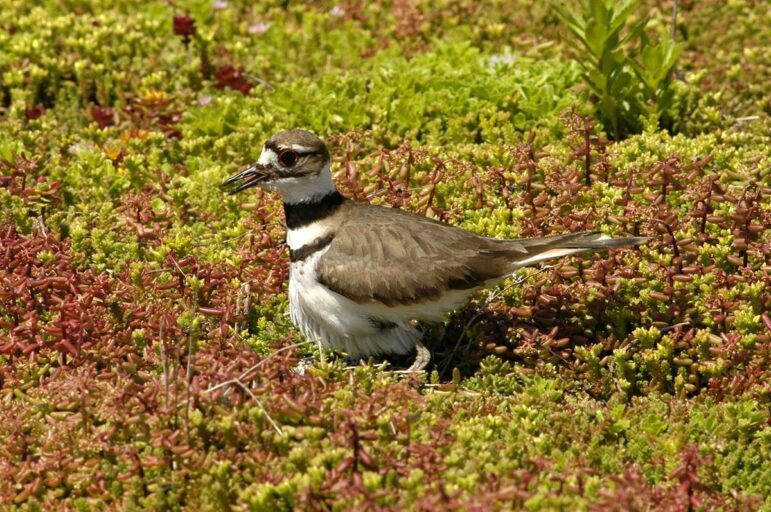
Don Russell, Ford Motor Co.
A killdeer on the green roof at the Ford Rouge Plant in Dearborn.By STEPHANIE RAUHE
Capital News Service
LANSING – As cities continue to expand, the amount of unused rooftop space grows too.
Steven Peck, the founder and president of Green Roofs for Healthy Cities, said that flat roofs are wasted spaces. The organization is an association of the green roof and wall industry.
“Roofs cover a portion of the Earth and they heat the city up like hot plates,” he said. “Building a green roof can save energy and help the city.”
In 2017, San Francisco became the first U.S. city to require that most new buildings install living vegetation or solar panels on rooftops, according to National Geographic.
Since then, several other cities throughout the U.S. have implemented similar laws, including New York City and Denver.
That trend has been working its way into Michigan, with cities making strides towards green sustainability.
Grand Rapids is “America’s Greenest City” and has received recognition worldwide for its sustainable development, according to Experience Grand Rapids, the city’s marketing and tourism promotion agency. It said the city’s goal is to reduce net carbon emissions by 50% by 2030 and reach 0% by 2050.
The Grand Rapids Downtown Market has indoor and outdoor facilities for farmers and artisans to sell and buy local produce. The building also has a thriving green roof, which has become a public space for visitors to relax,
Doni Burton, the business development manager for LiveRoof Global, said that Michigan has seen an increase in green roofs this year, though the projects are smaller in size. The company is based in Nunica in Ottawa County.
“I just started a green roof think tank in the Grand Rapids region,” said Burton. “It’s like a grassroots committee to start the conversation about having more green infrastructure.”
The Ford Rouge Factory boasts one of the largest living roofs in the world, spanning over 10 acres. Located atop the Dearborn Truck Plant final assembly building, it collects and filters stormwater runoff, improving water quality and reducing the waterflow into the Rouge River, according to the Henry Ford website.
The living roof also provides insulation for the plant, which lowers energy costs significantly, while extending the lifetime of the roof and putting the space to good use.
Peck said that the cost of building a green roof varies enormously depending on size. The initial cost to build one will be higher than for a standard roof, but it will save owners money over its lifetime.
According to a University of Michigan study, the average cost to build a green roof is $556,561 and the cost of a regular roof is $410,827. Over the lifetime of the green roof, an estimated $239,897 will be saved in energy costs.
The plants absorb heat and cool the building in the summer, while also insulating the building to reduce heat costs during the winter.
There are two main types of roofs, extensive and intensive.
Extensive green roofs are cheaper and have around 6 inches of growing medium for the plants. Intensive green roofs are more expensive and have 3 or more feet of growing medium, allowing for trees and shrubs.
According to Green Roofs for Healthy Cities, benefits include improved air quality and noise reduction, as well as providing amenity spaces such as a community garden.